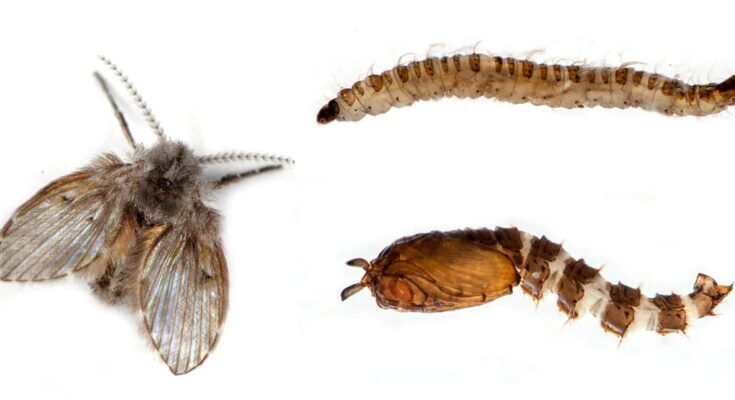Small and typically dark in color, moth flies (also known as drain flies) are around 1/8 inch long. They prefer to stay on walls rather than take to the air. They do not bite or cause injury, but the organic matter they feed on in the drain or sewage systems can be a breeding ground for bacteria.
Eliminating their nesting grounds is the most effective strategy for controlling these flies. This is especially common in the bathrooms of homes. The problem should be solved once and for all if the damp sludge or slime that lines the drain pipes is physically removed. Some alleviation may be seen after pouring hot water and/or bleach down a drain, but the sludge will likely return. The pipe interior should be cleaned using a combination of a firm bristles brush and drain cleaner. The J trap in the sink should also be cleaned. Enzyme cleaners, when used routinely, can help forestall the emergence of new issues.
In order to control moth flies, it is not essential to apply pesticides because the problem can be resolved by just eliminating their nesting grounds along with seeking help from Round Rock, TX pest control.
What can be done to eliminate drain flies?
The good news is that with consistent cleaning and careful attention, you can resolve drain fly in a week or less. You can accomplish this in five ways:
- Get started by using your regular cleaning product on the sink and drain. Scrub the drain’s interior and exterior with a pipe brush.
- To get rid of drain flies quickly and easily, just pour boiling water down the drain. Once or twice a week, boil a pot of water and pour it down and around the drain.
- Baking soda is another simple solution: Pour 1 cup of vinegar down the drain along with 1/2 cup of salt and 1/2 cup of baking soda. Put it off until the morning, then finish by pouring boiling water down the drain.
- A commercial drain cleaner, such as Drano or Bio-Clean, can be used for more severe cases of drain fly infestation. Drain flies can be prevented from reproducing by using chemical unclogging solutions to remove debris and other potential breeding materials from the drain and pipes.
- Make an apple cider vinegar trap. To do so, you can take a small dish and plastic wrap if you continue to observe adult drain flies. If you poke holes in the plastic, the flies will be drawn in, but they will not be able to get out.




